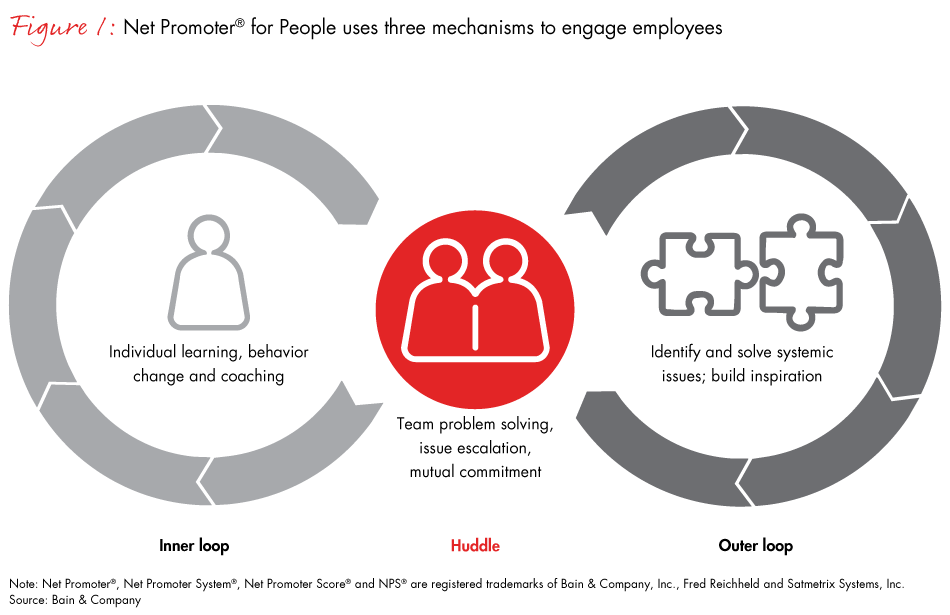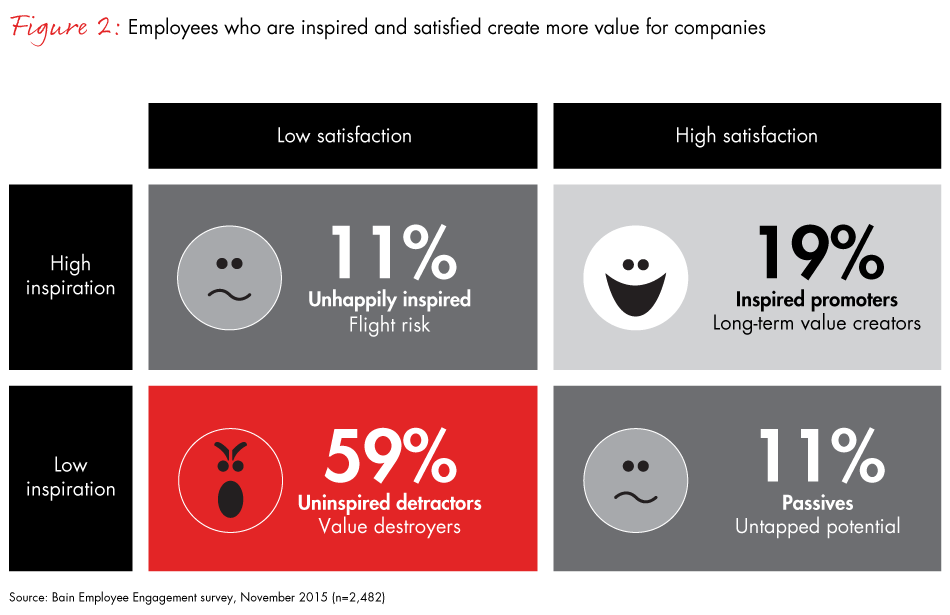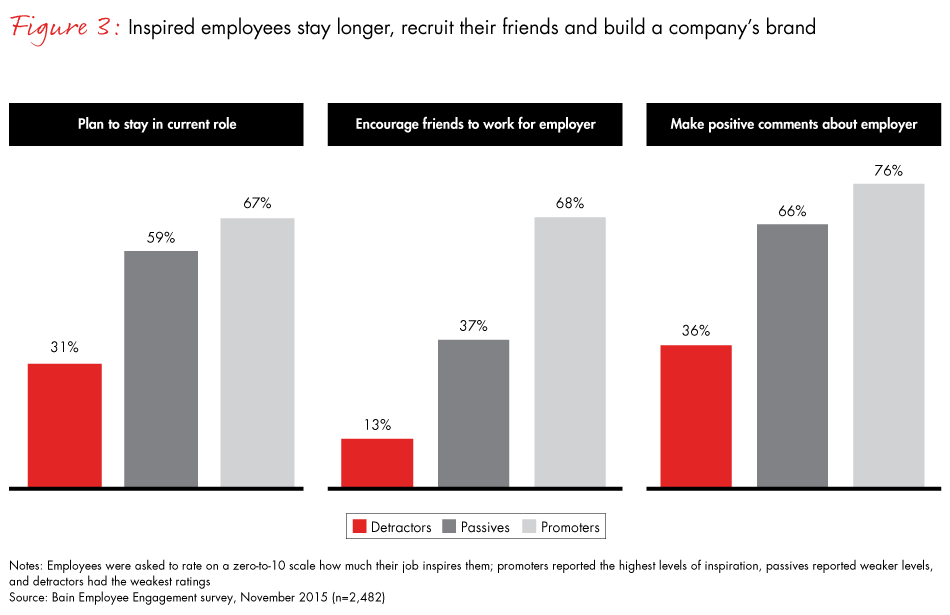Brief

One of the most important lessons that Net Promoter® companies taught us was that the system’s success in unlocking customer loyalty relied on its ability to inspire deep commitment from employees—harnessing their energy, enthusiasm and creativity. We first had this epiphany while observing Apple Stores.
Most retail jobs tend to be high-turnover, low-wage, low-satisfaction positions. But something altogether different was happening in Apple Stores—employees were bringing their authentic selves to work, allowing them to genuinely connect with customers. Employees were giving honest advice, which made interactions feel less like sales transactions and more like personalized technology recommendations. Employees were devoting themselves to making Apple Stores even better for customers. As a result, Apple was earning the highest sales per square foot in retail. And competitors were taking note, rethinking their employee experience and value proposition.
Apple had adapted the Net Promoter System®, traditionally used on customers, to engage employees at its roughly 500 stores. In fact, Apple coined the term “Net Promoter for People.” And while you can’t attribute all of Apple’s success to Net Promoter for People, many of its signature store innovations emerged from the employees that the approach empowered.
Apple’s success prompted us to search for practices engendering similar employee inspiration and satisfaction at other companies—and we found many. Some are really making a significant impact. For example, Google applies data analytics to identify what drives high-performing teams. Enterprise Rent-A-Car trains its managers to see employees as partners rather than subordinates. And sporting goods chain REI uses social media to encourage employee feedback through its “company campfires.” Other ideas—such as Ping-Pong tables, free lunches and company swag—are trendy but may not be moving the needle.
We have spent the past several years studying these methods and distilling them into a simple approach that other companies could adopt to get the best performance and most satisfaction from their employees. We also drew from our early observations of how companies use the employee Net Promoter Score®—a simple and popular measure of engagement but one that does not incorporate a means for facilitating learning and lasting change.
Taking Apple’s cue, we call it Net Promoter for People. Just as the Net Promoter System provided a language and practices for using the Net Promoter Score to build customer loyalty, Net Promoter for People applies the same philosophy to inspiring employees. At its core, Net Promoter for People is about empowering employees to bring energy, enthusiasm and creativity to their roles so that customers come back, spend more and share their experiences with friends and family. It’s about creating a culture in which employees use their best judgment and ideas to delight customers and contribute to a company’s success.
Despite companies’ best efforts to engage their teams, more than half of employees say they are uninspired and dissatisfied in their roles, according to Bain research. Only 19% of employees say they’re inspired and satisfied—a huge opportunity for companies that learn to tap their teams’ potential. Inspired employees, for example, provide better service at a lower cost, creating more value for customers and shareholders. Bain research at one bank showed that employees with the highest employee Net Promoter Scores generated customer Net Promoter Scores that were more than three times higher. We have seen this same impact at other banks and in other industries.
For Net Promoter practitioners, Net Promoter for People will seem like a natural extension of their feedback and learning loops. For executives who are new to the Net Promoter ethos, meaningful change starts with confronting two questions:
- What would it take to unlock employees’ energy, enthusiasm and creativity?
- How would it enhance the customer experience?
Net Promoter for People at work
The huddle and the inner and outer loops of the Net Promoter System provide the critical communication channels for companies trying to foster customer-centric cultures. In Net Promoter for People, those mechanisms go a step further by amplifying the voice of employees who are trying to do right on behalf of customers (see Figure 1).

Huddles—building an owner’s mindset through teamwork. In Net Promoter for People, just like in the Net Promoter System, employees at every level of a company hold short, regular meetings to discuss customer feedback and show gratitude toward colleagues’ contributions.
Employees, especially those who work directly with customers, often feel that they are at the mercy of a company’s policies. Put yourself in the shoes of a customer service representative who must deal with customer complaints about confusing bills. Huddles give these employees an opportunity to discuss the challenges they face, separating the issues they can address themselves from those that require input from others in an organization. Huddles give employees a voice and a way to escalate problems that are outside their control, helping employees feel heard and supported by management.
Huddles also provide a forum for employees’ best ideas. Before a huddle, a team member might collect colleagues’ feedback to set the agenda. From there, employees will use the time to set goals for their team’s efforts, identify potential barriers to reaching them and brainstorm process and service improvements. In the most effective huddles, managers stand back and let team members wrestle with critical issues with minimal interference. This approach encourages team members to own their successes and problems, and take responsibility for their own work environment. During these debates, members feed off of each other’s energy and creativity, giving rise to truly unique solutions. Employees emerge feeling more connected with each other and the company’s mission. In short, they feel like a winning team.
The inner loop—turning employee feedback into action. In the Net Promoter System, companies collect, share and act on customer feedback within the inner loop, with the goal of identifying broader solutions and opportunities. The inner loop serves a similar feedback-and-action purpose in Net Promoter for People, except that the input comes from employees at the team level, allowing supervisors to get ahead of budding problems or identify potential opportunities.
Similar to the Net Promoter System, the goal of Net Promoter for People is action, not rote data collection or measurement. In the most effective inner loops, employees feel safe to raise concerns and share observations without fear of retaliation, even if the feedback is difficult for managers to hear. To achieve that level of honesty, the best Net Promoter for People practitioners encourage employees to give feedback anonymously so that managers can act on the information.
In contrast to the huddle’s group problem-solving approach, a strong inner loop facilitates thoughtful coaching by supervisors and deliberate practice among employees who are trying to master their jobs. The most skilled supervisors use a combination of instruction, exercises and constant feedback to help employees reach their full potential. Effective leaders know how to help others solve their problems, rather than act unilaterally.
The best leaders inspire their employees. They bring their authentic selves to work every day and flex their strengths to help those they manage grow. There’s no magic combination of qualities that make a leader inspiring—Bain research suggests that embodying any four of 33 distinct attributes is enough to set a person apart.
The outer loop—how employee feedback feeds larger initiatives. In the Net Promoter System, the outer loop is where senior leaders assess and prioritize high-level initiatives and investments based on their potential impact and value. In Net Promoter for People, the outer loop is where senior leaders consider not only companywide concerns that emerge from huddles but broader people issues—whether the company has created the conditions for inspiration and what it could do to further empower employees.
A strong outer loop has three qualities:
- It’s robust, relying on input from a wide variety of sources, including customers, employees, benchmarking data and other sources to guide decisions.
- It’s rigorous so that it can gauge how a given initiative might affect retention, revenue and other measures.
- It’s transparent so that it inspires confidence among employees who can see the company’s efforts to improve.
These qualities ensure the integrity of the outer loop. After all, it’s all right if a company decides to forgo an employee’s or team’s suggestion as long as it followed its standard process, applied its criteria and provided a thoughtful explanation. It’s even better if a company can keep the suggestion on file in case circumstances change.
AT&T, a longtime Net Promoter company, has forged a sophisticated employee feedback system to support its frontline employees. When these employees face a question they can’t answer or a problem they can’t fix, they can request a solution from an internal expert through the company’s homegrown “Hero” system. If the employee isn’t happy with the expert’s response, he or she can challenge the expert to find a better answer.
Feedback that fuels meaningful change
Rather than rely on one primary feedback channel, Net Promoter for People companies collect input using multiple approaches, from weekly pulse checks to annual surveys. The goal is to gain a holistic, honest view of a company’s relationship with its employees, not to measure their performance. Turning feedback requests into ad hoc reviews risks undermining employees’ trust, prompting them to censor their answers. And worse, it can stoke employee cynicism and defensiveness, making it harder for a company to inspire change.
At a minimum, Net Promoter for People companies collect feedback three ways:
Annual surveys. Comprehensive, multiquestion surveys sent once a year allow companies to set benchmarks around their employee relationships. They can also help companies uncover systemic issues that affect more than one department, allowing them to prioritize initiatives and investments that can lead to a more inspired workforce.
Upward feedback for supervisors. Seeking employee feedback routinely about managers helps supervisors provide better coaching and spot potential service roadblocks before they become pervasive problems. These input requests also let employees know that they are active partners with their supervisors, not mere subordinates.
Huddle input and pulse checks. Regular requests for brief feedback let employees know that their opinions are not only welcomed but expected. In Net Promoter for People, this feedback (typically submitted anonymously) provides a valuable outlet for employees to air frustrations and informs regular huddle discussions.
Defining and measuring inspiration
Companies that provide basic tools and training, a safe work environment, fair compensation and growth opportunities might satisfy their employees. But is that enough to inspire them? Just as customers need more than fast service to feel good about a purchase, employees need more than the basics to bring their best to work each day.
Net Promoter for People companies aim to create the right conditions for authentic inspiration. Bain research suggests that the following five factors contribute most:
- Purpose—when employees find a company’s purpose and their contribution to it meaningful;
- Fit—when an employee’s job fits his or her skills, interests and aspirations;
- Autonomy—when employees feel empowered to find better ways to do their jobs;
- Leadership quality—when employees feel inspired by their leaders, especially their supervisors; and
- Affiliation—when employees feel proud to be part of their teams.
Of course, companies will seek to measure employees’ inspiration levels and put them in dollar terms, just as they gauge loyalty economics in the Net Promoter System. Bain’s research suggests that inspired promoters—employees who report high levels of inspiration and satisfaction—become a company’s long-term value creators (see Figure 2).

And the potential benefits are clear: A Bain survey of almost 2,500 employees found that 67% of employee promoters planned to stay in their current role, reducing recruiting costs, compared with 31% of detractors. And they share their happiness publicly: 76% of promoters said they made positive comments about their employer over the past year compared with 36% of detractors (see Figure 3).

Employee inspiration represents a huge opportunity that few are harnessing. Companies that use the Net Promoter System to build customer loyalty are a step ahead in creating workforces that are self-directing and self-correcting—internally driven to do the right thing for customers and the business. Net Promoter for People will bring many a step closer to unlocking the energy, enthusiasm and creativity of some of the biggest potential advocates: their employees.
Darci Darnell leads Bain & Company’s Customer Strategy & Marketing practice in the Americas, and she is based in the Chicago office. Rob Markey leads Bain’s Global Customer Strategy & Marketing practice, he is based in the New York office, and he is coauthor of the best seller The Ultimate Question 2.0: How Net Promoter Companies Thrive in a Customer-Driven World.
Net Promoter®, Net Promoter System®, Net Promoter Score® and NPS® are registered trademarks of Bain & Company, Inc., Fred Reichheld and Satmetrix Systems, Inc.


